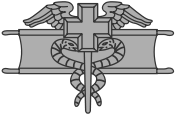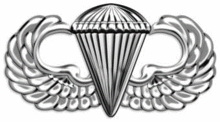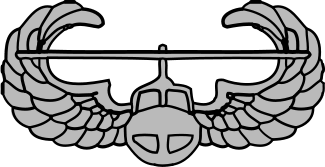Rhonda Cornum
| Rhonda Cornum PhD, MD | |
|---|---|
.jpg) | |
| Born |
October 31, 1954 Dayton, Ohio, U.S. |
| Allegiance |
|
| Service/branch |
|
| Years of service | 1978-2012 |
| Rank |
|
| Battles/wars | Persian Gulf War (POW) |
| Awards |
Legion of Merit (3) Distinguished Flying Cross Bronze Star Medal Prisoner of War Medal |
| Spouse(s) | Kory Cornum |
Rhonda Cornum (born October 31, 1954) is a former United States Army officer and the Director of Health Strategy for TechWerks.[1] She is a surgeon, board-certified in urology, having graduated from the Uniformed Services University of the Health Sciences, first having earned a doctorate in biochemistry and nutrition from Cornell University. She retired in 2012 as a U.S. Army Brigadier General the Director of Comprehensive Soldier Fitness in the Army Staff G-3/5/7 division.[2]
She commanded the Landstuhl Regional Medical Center, was president of her class at the National War College, and then became the command surgeon for United States Army Forces Command. As a brigadier general, she was U.S. Army Assistant Surgeon General for Force Protection before working in the joint soldier fitness program. Brigadier General Cornum retired on 31 January 2012.
Early life and education
After her training in biochemstry, she attended the national military medical school. During her studies, she met her future husband, Kory Cornum, who would have a parallel military career in the U.S. Air Force and also attain the rank of brigadier general.
Career
At the U.S. Army Aviation Center, Cornum both researched and worked as a flight surgeon at the United States Army Aviation Center of Excellence. Her interests were focused on the human factors of flight.[3]
Persian Gulf War
As a flight surgeon with the 229th Attack Helicopter Regiment, then-Major Cornum was aboard a Black Hawk helicopter on a search and rescue mission, looking for a downed F-16 pilot, during the Persian Gulf War.[4] When the helicopter was shot down on February 27, 1991, she suffered two broken arms, a broken finger, a gunshot wound in the back, and other injuries.[4] After regaining consciousness, she said her first thought was "Nobody’s ever died from pain."[5]
Cornum was captured, made a prisoner of war (POW), and sexually assaulted by one of her Iraqi captors.[6] In addition, she was subjected, with other prisoners, to a mock execution.[5] Nevertheless, when she was the senior-ranking prisoner, she took responsibility for other POWs. She later co-wrote a book about her experiences, She Went to War: the Rhonda Cornum Story (ISBN 0891415076), with Peter Copeland.
In an interview with the New York Times, she said the sexual assault "ranks as unpleasant; that's all it ranks....everyone's made such a big deal about this indecent assault, but the only thing that makes it indecent is that it was nonconsensual. I asked myself, 'Is it going to prevent me from getting out of here? Is there a risk of death attached to it? Is it permanently disabling? Is it permanently disfiguring? Lastly, is it excruciating?' If it doesn't fit one of those five categories, then it isn't important." She continued, "there's a phenomenal amount of focus on this for the women but not for the men," citing that the "mistreatment of [fellow POW] Major Jeffrey S. Tice of the Air Force, who had a tooth explode from its socket when he was tortured with jolts of electricity."
She testified about this to the Presidential Commission on the Assignment of Women in the Armed Services. Initially, she did not mention this abuse, at the request of her chain of command, when first repatriated. She gave additional detail in her book.
Awards and decorations
Cornum's decorations include the Army Distinguished Service Medal,[7] Legion of Merit (with two oak leaf clusters), Distinguished Flying Cross, Bronze Star, Meritorious Service Medal (with four oak leaf clusters), Purple Heart, Air Medal, and Prisoner of War Medal.[2] She is one of only seven women in history to receive the Distinguished Flying Cross.
 | ||
 | ||
 | ||
 | ||
| 1st Badge | Expert Field Medical Badge | ||
|---|---|---|---|
| 2nd Badge | Senior Flight Surgeon Badge | ||
| 3rd Badge | Parachutist Badge | ||
| 4th Badge | Air Assault Badge | ||
| 1st Row | Army Distinguished Service Medal | Legion of Merit with two Oak Leaf Clusters | Distinguished Flying Cross |
| 2nd Row | Bronze Star Medal | Purple Heart | Meritorious Service Medal with four Oak Leaf Clusters |
| 3rd Row | Air Medal | Army Commendation Medal with Oak Leaf Cluster | Achievement Medal with two Oak Leaf Clusters |
| 4th Row | Prisoner of War Medal | National Defense Service Medal with service star | Armed Forces Expeditionary Medal |
| 5th Row | Southwest Asia Service Medal with two campaign stars | Global War on Terrorism Service Medal | Army Service Ribbon |
| 6th Row | NATO Medal | Kuwait Liberation Medal (Saudi Arabia) | Kuwait Liberation Medal (Kuwait) |
References
| Wikimedia Commons has media related to Rhonda Cornum. |
- ↑ "About Us". TechWerks.
- 1 2 "Brigadier General Rhonda Cornum, Ph.D., M.D." (PDF). United States Army Combined Arms Center. Retrieved January 21, 2011.
- ↑ Rhonda Cornum (Nov–Dec 1989). "Crew Endurance: a New Perspective". United States Army Aviation Digest. 35 (9).
- 1 2 "A Woman's Burden". Time magazine. March 28, 2003.
- 1 2 "Nobody has ever died from Pain". U.S. Army Reserve. Retrieved August 4, 2012.
- ↑ "war story: rhonda cornum". pbs.org. Retrieved January 21, 2011.
- ↑ "Rhonda L. Cornum" (PDF). Profiles of Women Soldiers. Official Homepage of the United States Army. Retrieved 28 September 2013. External link in
|publisher=, |work=(help)